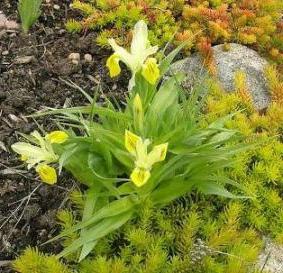Bulbous iris has long been attributed to the genus of irises, highlighting them as a separate group of bulbous. And only in the middle of the last century “false” irises were singled out as an independent genus. Iridodictium - small-bulbous irises. Xyphium are large-bulbous representatives of irises.
I must say that these two species are completely different. And if you have to tinker with the second ones, then the first completely unpretentious plants. It is about them that will be discussed later.
Iridodictiums (bulbous irises) have elegant flowers that are really similar to iris flowers. In Russia they are also called "kasatiki", which means - welcome, sweet. They are characterized by their unpretentiousness in growing, and different flowering periods will help you to enjoy for quite a long time. They appear at the same time as crocuses. Unlike large onion irises, flowers develop earlier than leaves.
The very first iris will appear onion "Danford" - an impatient crumb (height 10 cm) with yellow small flowers in a speck of greenish color. This persistent soldier will bravely resist night frosts and other troubles of early spring. This plant was found in the mountains of Turkey, and Ms. Dunford was introduced into the cultural planting, hence the name of the variety.
Onion net irises are the most popular iridodictiums in the culture; there are more than 20 varieties of them. They begin to bloom in early April, almost at the same time as large-flowered crocuses.
Flowering lasts up to 3 weeks, the plant is unpretentious in cultivation, perfectly propagates vegetatively. For a year, it forms up to four young bulbs, the length of which is 3-4 cm, and the diameter is no more than 1.5-2.5 cm, while
the bulb has a mesh-fibrous membrane. The height of these irises reaches 15 cm, fragrant flowers are 5-7 cm in size. They can be juicy
blue, blue or purple, on the lower petal there is a white or bright yellow-orange spot. The most popular varieties: "Edward", "Harmony", "Paulina", "Canteb". But the varieties "Natasha" and "Alba" will be white.
As mentioned above, growing onion iris is easy. It is a winter-hardy, maintenance-free crop. Sunny, open areas with neutral, drained or slightly alkaline soil are perfect for her. The only condition is the dry content during the period of summer rest. In natural nature, it can be found in the mountains and foothills of Central and Asia Minor, as well as in the Caucasus.

Therefore, for this plant, spring with precipitation, dry summers, and winters are snowy and without thaws are desirable. If your climate does not correspond to this, but, on the contrary, provides too rainy summers, then bulbous iris should be planted near a large tree (on the south side) or on a raised hill. You can still dig the bulbs in the summer after flowering, this must be done as soon as the leaves begin to lie down, and their upper part turns yellow. Bulbs should be stored in a dark place in sawdust. And starting from the end of September and in the month of October, they again land to a depth of 7-8 cm, with a distance between plants of 10-15 cm. Iridodictiums are excellent for spacious flower beds, for flowerpots in the yard, for
alpine slides and lawns with large stones. Thanks to early flowering and rich colors, they give a special pleasure after a long and monotonous winter.